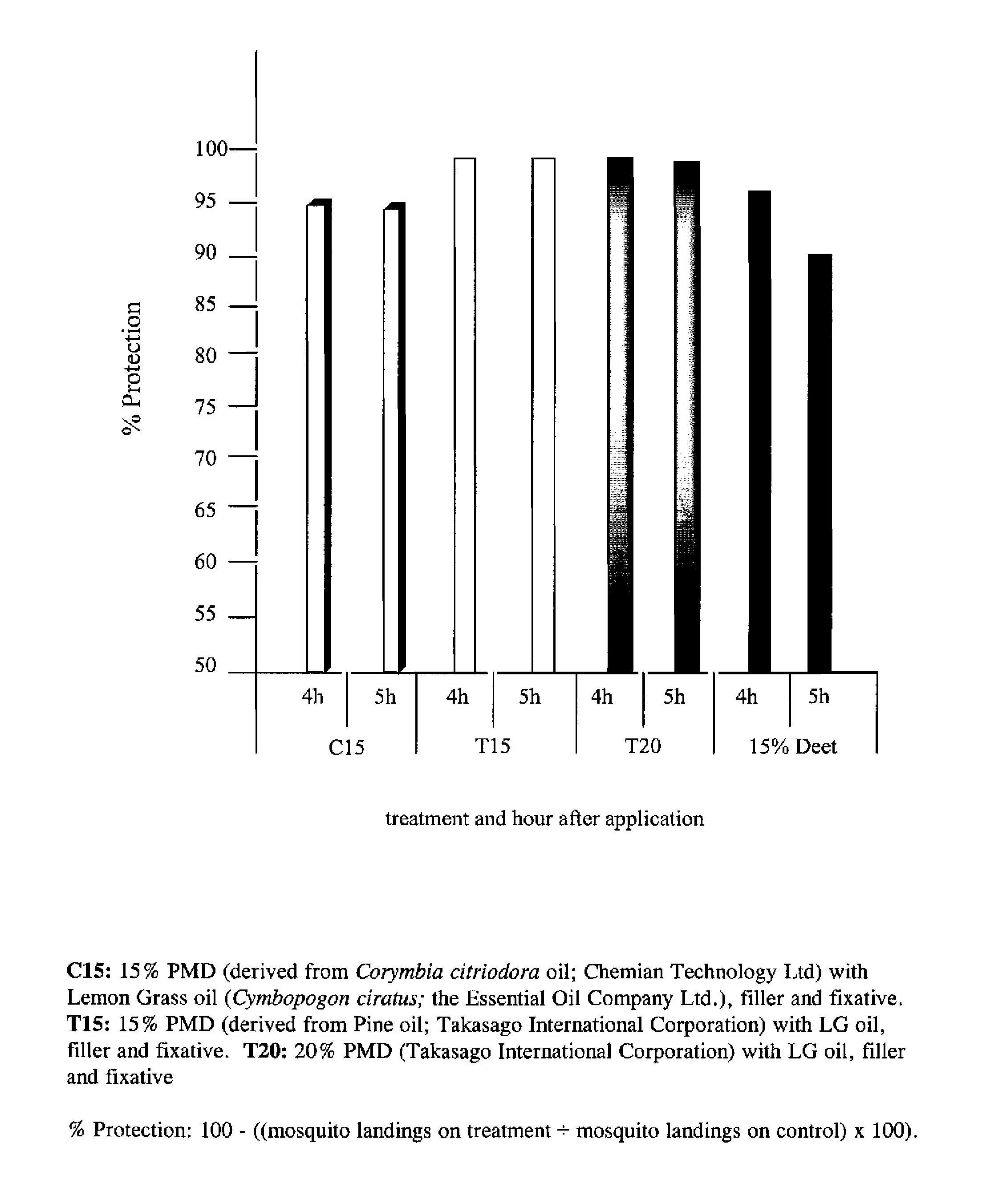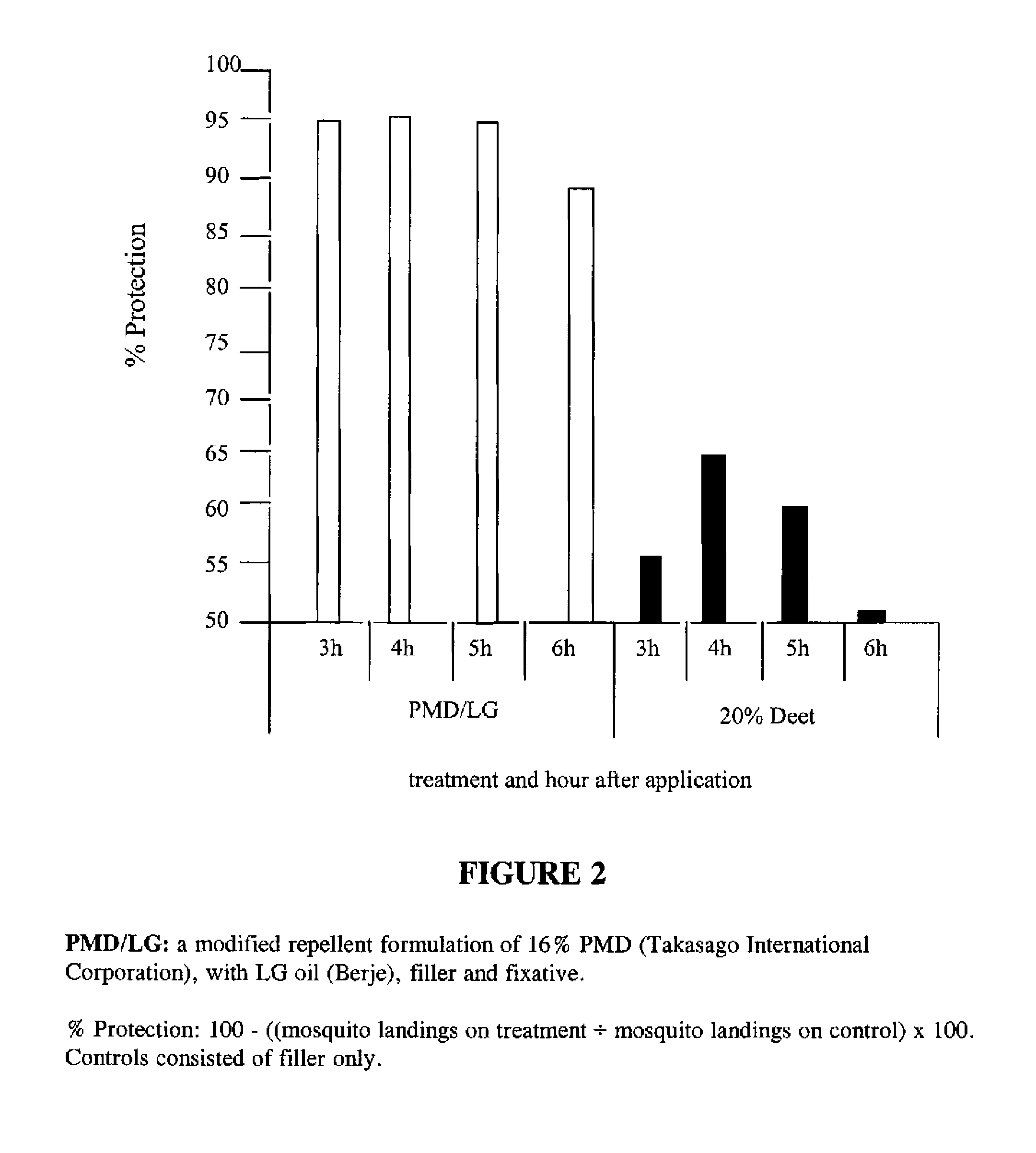Insect repellent composition
a technology of insect repellent and composition, applied in the direction of drug composition, biocide, plant/algae/fungi/lichens ingredients, etc., can solve the problems of insect bites, serious health danger, transmission of life-threatening and debilitating diseases,
- Summary
- Abstract
- Description
- Claims
- Application Information
AI Technical Summary
Benefits of technology
Problems solved by technology
Method used
Image
Examples
example 1
Two Phase Formulation
[0037]
INGREDIENTSPERCENT (wt %)Mineral oil39.0%Ethanol26.0%p-menthane-3,8-diol16.0%dipropylene glycol8.5%lemon grass oil5.0%Vanillin5.5%
[0038]The use level of the repellent combination in the lotion formulation for the following example was 26.5 wt %.
[0039]Vanillin was added to the formulation last. Prior to adding the vanillin, heat is applied to the PMD so that it has a viscosity suitable for introduction to the admixture. The resulting composition has a non-greasy feel, and has the viscosity of a light oil.
[0040]A suitable volume of the above formulation to be applied to a the skin of the user is about 2 ml per 1000 cm2 of skin. The formulation should be clear two-phase formulation and can be then filled into suitable plastic containers (PET preferred) and is to be shaken vigorously before applied to a user.
example 2
One Phase Formulation
[0041]The following ingredients were combined as described below:
[0042]
IngredientSupplierPercentage (wt %)Mineral OilISP30.00IsoparaffinicExxonMobilA8.00Hydrocarbonp-menthane-3,8-diolTakasago16.00Isononyl acetateIFF35.50Lemongrass oilBerje Guatamala5.00VanillinRhodia5.50AAvailable under the trademark Isopar L
Procedure[0043]1. In a suitable vessel, mix the Mineral oil, Isopar L and the p-Menthane-3,8-diol. The PMD may need to be heated slightly (about 100° F.) so that it is liquid. This solution should be clear.[0044]2. In a separate vessel, mix the Isononyl Acetate, Lemongrass Oil and Vanillin until the Vanillin is completely dissolved and the solution is clear. Very slight heat will quicken this (100° F.).[0045]3. With agitation, add part 2 to part 1 and mix until uniform.
[0046]The formulation should be clear and can be then filled into suitable plastic containers (PET preferred).
example 3
Gel Formulation
[0047]The following ingredients were added sequentially:
[0048]
1) WATER42.95%2) MINERAL OIL30.00%3) PMD 16.0%4) XANTHAN GUM 0.55%5) VANILLIN 5.5%6) LEMONGRASS OIL 5.0%
[0049]The admixture was mixed until a viscous gel was formed. Viscosity of the gel may be adjusted based on the amount of the gelling agent (xanthan gum).
Example 4
Evaluation of the Efficacy of the Formulation of Example 1
[0050]Study A—Guatemala Study. The following repellent formulations (% by weight) were used: (1) C15: repellent containing the amounts of ingredients described in Example 1—the PMD obtained from acid modification of Corymbia citriodora oil, CAS: 42822-86-6, purchased from Chemian Technology Ltd under the trademark Citriodiol®; (2) T15: repellent containing the amounts of ingredients described in Example 1—the PMD obtained from Coolact® 38D; (3) T20: containing 20 wt % PMD instead of 15%, obtained from Coolact® 38D; (4) positive control: 15% DEET (N,N-diethyl-meta-toluamide, CAS 134-62-3; ...
PUM
 Login to View More
Login to View More Abstract
Description
Claims
Application Information
 Login to View More
Login to View More - R&D
- Intellectual Property
- Life Sciences
- Materials
- Tech Scout
- Unparalleled Data Quality
- Higher Quality Content
- 60% Fewer Hallucinations
Browse by: Latest US Patents, China's latest patents, Technical Efficacy Thesaurus, Application Domain, Technology Topic, Popular Technical Reports.
© 2025 PatSnap. All rights reserved.Legal|Privacy policy|Modern Slavery Act Transparency Statement|Sitemap|About US| Contact US: help@patsnap.com



